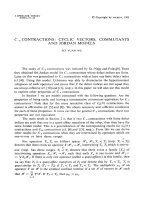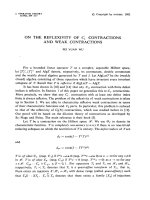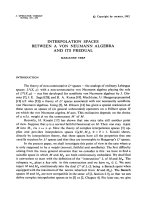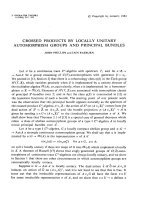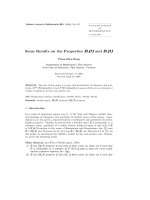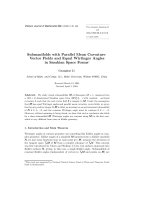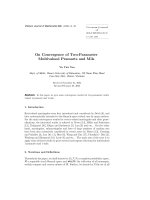Báo cáo toán học: "Mutually Disjoint Steiner Systems S(5, 8, 24) and 5-(24, 12, 48) Designs" docx
Bạn đang xem bản rút gọn của tài liệu. Xem và tải ngay bản đầy đủ của tài liệu tại đây (97.47 KB, 6 trang )
Mutually Disjoint Steiner Systems S(5, 8, 24) and
5-(24, 12, 48) Designs
Makoto Araya
Department of Computer Science
Shizuoka University
Hamamatsu 432–8011, Japan
Masaaki Harada
Department of Mathematical Sciences
Yamagata University
Yamagata 990–8560, Japan and
PRESTO, Japan Science and Technology Agency
Kawaguchi, Saitama 332–0012, Japan
Submitted: Aug 4, 2009; Accepted: Dec 9, 2009; Publish ed : Jan 5, 2010
Mathematics Subject Classifications: 05B05
Abstract
We demonstrate that there are at least 50 mutually disjoint Steiner systems
S(5, 8, 24) and there are at least 35 mutually disjoint 5-(24, 12, 48) designs. The lat-
ter result provides the existence of a simple 5-(24, 12, 6m) design for m = 24, 32, 40,
48, 56, 64, 72, 80, 112, 120, 128, 136, 144, 152, 160, 168, 200, 208, 216, 224, 232, 240, 248
and 256.
1 Introduction
A t-(v, k, λ) design D is a pair of a set X of v points and a collection B of k-subsets of
X called blocks such that every t-subset of X is contained in exactly λ blocks. We often
denote the design D by (X, B). A design with no repeated block is called simple. All
designs in this note a re simple. A Steiner system S(t, k, v) is a t-(v, k, λ ) design with
λ = 1. Two t-(v, k, λ) designs with the same p oint set are said to be disjoint if they
have no blocks in common. Two t-(v, k, λ) designs are isomorphic if there is a bijection
between their point sets that maps the blocks of the first design into the blocks of the
second design. An automorphism of a t-(v, k, λ) design D is any isomorphism of the design
with itself and the set consisting of a ll automorphisms of D is called the automorphism
group Aut(D) of D.
The well-known Steiner system S(5, 8, 2 4) and a 5-(24, 12 , 48) design are constructed
by taking as blocks the supports of codewords of weights 8 and 12 in the extended Go-
lay [24, 12, 8] code, respectively. It is well known that there is a unique Steiner system
S(5, 8, 24) up to isomorphism [8], and there is a unique 5-(24, 12, 48) design having even
the electronic journal of combinatorics 17 (2010), #N1 1
block intersection numbers [7]. By finding permutations on 24 points such that all images
of a Steiner system S(5, 8, 24) under these permutations are mutually disjoint, Kramer and
Magliveras [6] found nine mutually disjoint Steiner systems S(5, 8, 24). Then Araya [1]
found 15 mutually disjoint Steiner systems S(5, 8, 24). Recently Jimbo and Shiromoto [4]
have found 22 mutually disjoint Steiner systems S(5, 8, 24 ) and two disjoint 5-(24, 12, 48)
designs.
Our computer search has found more mutually disjoint Steiner systems S(5, 8, 2 4) and
5-(24, 12, 4 8) designs.
Proposition 1. There are at least 50 mutually disjoint Steiner systems S(5, 8, 24). There
are at least 35 mutually disjoint 5-(24, 12, 48 ) designs.
Let (X, B
1
), (X, B
2
), . . . , (X, B
35
) be 35 mutually disjoint 5-( 24, 12, 48) designs. Then
for any non-empty subset S ⊂ {1, 2, . . . , 35}, (X, ∪
i∈S
B
i
) is a simple 5-(24, 12, 48|S|)
design. Hence this provides the existence of the following designs. We remark that if a
5-(24, 12, λ) design exists then λ is divisible by 6.
Corollary 2. There is a simple 5-(24 , 12, 6m) design for
m = 24, 32, 40, 48, 56, 64, 72, 80, 112, 120, 128, 136,
144, 152, 160 , 168, 200, 20 8 , 216, 224, 232, 240, 2 48 and 256.
For the a bove m, 5-(24, 12, 6m) designs are constructed for the first time (see Table
4.46 in [5]). In addition, we have verified that there is a 5-(24, 12, 48s) design with a
trivial a uto morphism group for s = 2, 3, . . . , 35.
2 Preliminaries
To give description of mutually disjoint 5 -designs, we first define the extended Golay
[24, 12, 8] code G
24
as the code with generator matrix
1
I
12
A
.
.
.
1
1 · · · 1 0
,
where A is the circulant matrix with first row (1, 1, 0, 1, 1 , 1, 0, 0, 0, 1, 0) and I
12
is the
identity matrix of order 12. The Steiner system S(5, 8, 24) and the 5-(24, 12, 48) design
are constructed by t aking as blocks the supports of codewords of weights 8 and 12 in
G
24
, respectively. We denote these 5-designs by D
8
= (X
24
, B
1
) and D
12
= (X
24
, B
2
),
respectively, where X
24
= {1, 2, . . . , 24} (see [4]).
Let σ be a permutation on 2 4 points X
24
. For i = 1 and 2 , B
σ
i
denotes {B
σ
| B ∈ B
i
}
where B
σ
denotes the image of a block B under σ. Similar to [1] and [6], in this note,
we find permutations σ such that (X
24
, B
σ
i
) are mutually disjoint. It is well known that
the electronic journal of combinatorics 17 (2010), #N1 2
both automorphism groups Aut(D
8
) and Aut(D
12
) are the Mathieu group M
24
. If α and
β are in the same right coset for M
24
in the symmetric group S
24
on X
24
then B
α
i
= B
β
i
.
Hence we o nly consider right coset representatives of M
24
in S
24
. One can calculate right
coset representatives by using the method in [3] as fo llows. For disjoint subsets ∆ and ∆
′
of X
24
, we define a subset of S
24
:
Select(∆, ∆
′
) = {id}∪
(∪
k
i=1
{(γ
1
, δ
1
)(γ
2
, δ
2
) · · · ( γ
i
, δ
i
) | γ
1
< · · · < γ
i
∈ ∆, δ
1
< · · · < δ
i
∈ ∆
′
}),
where k = min{|∆|, |∆
′
|} and id is the identity permutation. Let Sym(Ω) denote the
symmetric gro up on a set Ω. Then it follows from [3, Section 4] that H
(7)
U
7
U
6
U
5
· · · U
1
is
the set of all right coset representatives of M
24
in S
24
where
U
i
= {id} (i = 1, 2, . . . , 5),
U
6
= Select({6, 7, 8, 9, 11, 12, 13, 14, 15 , 16, 17, 18, 20, 21, 23, 24}, {10, 19, 22}),
U
7
= Select({7, 13, 21}, {8, 9, 11, 12, 14, 15, 16, 17, 18, 20, 2 3 , 24}),
H
(7)
= Sym({13, 21}) × Sym({8, 9, 11, 12, 14, 15, 16, 17, 18, 20, 23, 24})
× Sym({ 10, 19, 22}).
We note that |U
6
| = 969 and |U
7
| = 455.
3 Description of mutually disjoint 5-designs
3.1 Mutually disjoint Steiner systems S(5, 8, 24)
We define the following set of 22 permutations:
G
1
= {σ
i
τ
j
| i = 0, 1, . . . , 10, j = 0, 1}
where
σ = (13, 14, 15, 16, 17, 18, 19, 20, 21, 22, 23),
τ = (1, 13)(2, 14)(3, 15)(4 , 16)(5, 17)(6, 18)(7, 19)(8, 20)(9, 21)(10, 22)(11, 23).
Recently Jimbo and Shiromoto [4] showed that the set {(X
24
, B
σ
1
) | σ ∈ G
1
} gives 22
mutually disjoint Steiner systems S(5, 8, 2 4).
Let H
1
be the set of all right coset representatives α of M
24
in S
24
satisfying the
condition that {(X
24
, B
σ
1
) | σ ∈ G
1
∪ {α}} gives 23 mutually disjoint Steiner systems
S(5, 8, 24) . Then we define the simple undirected graph Γ
1
, whose set of vertices is the
set G
1
∪ H
1
and two vertices α and β are adjacent if B
α
1
and B
β
1
are disjoint. Clearly a
t-clique in Γ
1
gives t mutually disjoint Steiner systems S(5, 8, 24). It seems infeasible to
construct the graph Γ
1
by computer. However, we found a subgraph Γ
′
1
of Γ
1
such that Γ
′
1
contains a 50-clique by considering subsets of the set H
(7)
U
7
U
6
U
5
· · · U
1
of all right coset
the electronic journal of combinatorics 17 (2010), #N1 3
Table 1: Permutations P
1
Permutations
α
1
= (6, 19, 10, 22)(7, 14, 15)(8, 17, 24, 11, 23, 13, 12)(9, 16, 21)
α
2
= (7, 15, 24, 13, 23, 12, 10, 9, 20, 8, 16, 14, 21, 22, 19, 11)
α
3
= (7, 19, 24, 11, 16, 12, 15, 23, 8, 14, 10, 22, 9)(13, 21, 17)
α
4
= (7, 22, 11, 15, 23, 8, 13, 16, 12, 14, 9, 10, 19)(18, 21)
α
5
= (6, 19, 11, 7, 22, 23, 10)(8, 16, 21, 14, 18, 13, 17, 9, 12, 15)
α
6
= (7, 8, 22, 23, 19, 15, 21, 17, 14)(9, 10, 24, 11, 12)
α
7
= (7, 17, 15, 8, 9, 20, 14)(10, 23, 22, 11, 24, 16, 21, 12)(18, 19)
α
8
= (8, 20, 14, 23, 13)(9, 12, 11, 17)(10, 24, 22, 16, 15, 19)
α
9
= (7, 17, 24, 9)(8, 15, 20, 22, 23, 19, 12, 18, 11, 21, 14, 13, 16)
α
10
= (7, 15, 17, 19, 14, 21, 13, 23, 12, 10, 9, 16, 24, 8)(18, 22)
α
11
= (6, 19, 7, 20, 24, 21, 16, 17, 15, 9, 12, 14, 23, 13, 11, 8, 22, 18, 10)
α
12
= (7, 18, 24, 9, 15, 8, 11, 10, 14, 22, 16, 12)(13, 19, 17, 21, 23)
α
13
= (7, 11, 15, 12, 13, 21, 14, 10, 19, 18, 22, 8, 20, 9)(16, 24)
α
14
= (8, 9, 12, 24, 11, 16, 14, 22, 23, 19, 15, 10, 20, 21)(13, 17)
α
15
= (7, 10, 23, 8)(9, 15, 18, 21, 13)(11, 14, 12, 19)(16, 24, 22)
α
16
= (8, 13, 17, 22, 9, 18)(11, 24, 21, 16, 12, 19)(14, 15, 20)
α
17
= (7, 14, 11)(8, 20, 21, 24, 22, 16, 10, 9)(12, 23)(13, 18, 19)(15, 17)
α
18
= (7, 19, 20, 22, 14, 13, 11, 24, 8, 16, 9, 15, 23, 10)
α
19
= (7, 16, 19, 9, 18, 8, 20, 24, 14, 12, 22, 21, 17, 13, 11, 15)
α
20
= (7, 15, 17, 10, 18, 9, 19, 24, 16)(8, 14, 20, 21, 11)
α
21
= (7, 14, 18, 13, 12, 22, 17, 9, 8, 10, 11)(15, 19, 23, 21, 24, 16, 20)
α
22
= (6, 19, 7, 22, 17, 10)(8, 9, 24, 14, 11, 16, 12, 15, 13)(20, 21)
α
23
= (8, 14, 21, 10, 15, 22, 19, 17, 12, 18, 11)(9, 20)(16, 24)
α
24
= (7, 23, 15, 21, 24, 13, 9)(8, 10, 16, 22)(11, 18, 14)(12, 17)
α
25
= (7, 17, 22, 23, 13, 24, 16, 11, 9, 15, 20, 14, 19, 12, 21, 10, 8)
α
26
= (7, 23, 9, 17, 12, 10, 15, 16, 14, 8, 19, 22, 21, 18, 13, 11)
α
27
= (7, 18, 12, 9, 17, 21, 11, 23, 13, 10, 24, 16, 15)(8, 19)(20, 22)
α
28
= (7, 9, 15, 22, 10, 11)(8, 19, 13, 24, 21, 16, 12, 20, 14)
representatives. This computation for finding cliques was performed using Magma [2].
The set {(X
24
, B
σ
1
) | σ ∈ G
1
∪P
1
} gives corresponding 50 mutually disjoint Steiner systems
S(5, 8, 24) where P
1
is listed in Table 1. Moreover we have verified by Magma [2] that
the simple 5-(24, 8, s + 22) design (X
24
, ∪
σ∈Y
B
σ
1
) has a trivial automorphism group where
Y = G
1
∪ {α
1
, α
2
, . . . , α
s
} for s = 1, 2, . . . , 28.
3.2 Mutually disjoint 5-(24, 12, 48) designs
For the 5-(24, 12, 48 ) design D
12
, by a back-tracking algorithm, we found the set G
2
=
{β
1
, β
2
, . . . , β
20
} of 20 permutations on 24 points satisfying the condition that {(X
24
, B
σ
2
) |
σ ∈ G
2
} gives 20 mutually disjoint 5-(24, 12, 48) designs where β
1
is the identity permu-
tation id. This was done by considering some subsets of the set H
(7)
U
7
U
6
U
5
· · · U
1
of all
right coset representatives of M
24
in S
24
.
Let H
2
be the set o f all right coset representatives β of M
24
in S
24
satisfying the
the electronic journal of combinatorics 17 (2010), #N1 4
condition that {(X
24
, B
σ
2
) | σ ∈ G
2
∪{β}} gives 21 mutually disjoint 5-(24, 12, 48 ) designs.
Similar to Γ
1
, we define the simple undirected graph Γ
2
where G
2
∪H
2
is the set of vertices.
In this case, we found a subgraph Γ
′
2
of Γ
2
such that Γ
′
2
contains a 35-clique by considering
subsets of the set H
(7)
U
7
U
6
U
5
· · · U
1
. We list in Table 2 the set P
2
of 35 permutations
corresponding to the 35-clique in Γ
′
2
, where the set {(X
24
, B
σ
2
) | σ ∈ P
2
} gives 35 mutually
disjoint 5-(24, 1 2 , 48) designs. As described in Section 1, a simple 5-(24, 12, 48s) design
can be constructed from the 35 mutually disjoint 5-(24, 12, 48) designs for s = 2, 3, . . . , 35 .
Moreover we have verified by Magma [2] that the 5-(24, 12, 48s) design (X
24
, ∪
s
i=1
B
β
i
2
)
has a trivial a uto morphism group for s = 2, 3, . . . , 3 5.
Table 2: Permutations P
2
Permutations
β
1
= id (the identity per mutation)
β
2
= (7, 19, 21, 12, 22, 16, 10, 8)(11, 13)
β
3
= (7, 8, 22, 11, 21, 10)(9, 13)(17 , 19)
β
4
= (6, 22, 20, 10)(7, 8)(9, 13)(11, 19)(16, 21)
β
5
= (7, 8)(10, 11, 13, 22, 17, 21)(18, 19)
β
6
= (7, 8, 22, 13, 14, 10)(9, 19)(15 , 21)
β
7
= (7, 9, 22, 23, 10)(11, 13)(16, 2 1)(19, 20)
β
8
= (7, 19, 18, 22, 24, 10)(9, 13)(14, 21)
β
9
= (10, 12, 19, 20, 13, 22, 15)(21, 24)
β
10
= (6, 22, 16, 19, 15, 10)(13, 14)(21, 24)
β
11
= (9, 22, 24, 19, 12, 10)(13, 16)(20, 21)
β
12
= (10, 17, 13, 15, 21, 19, 23, 22)
β
13
= (7, 11, 19, 14, 22, 24, 13, 15, 21, 10)
β
14
= (6, 10)(11, 22, 21, 23, 13, 12, 19)
β
15
= (7, 9, 24, 8)(10, 16, 21, 17, 19, 13, 22, 23)
β
16
= (7, 15, 19)(8, 22, 21, 23, 13, 20, 10, 9, 24)
β
17
= (6, 22, 8, 7, 9, 24, 19, 16, 10)(13, 14, 21)
β
18
= (8, 11, 22, 20, 19, 21, 10, 24)(13, 17)
β
19
= (6, 22, 20, 10)(7, 15)(8, 18, 13 , 16, 21, 24)(9, 19)
β
20
= (7, 19, 9, 22, 13, 17, 21, 8, 23, 24, 10)
β
21
= (7, 22, 20, 19, 17, 10)(8, 12, 24, 13)(9, 11, 21)
β
22
= (7, 22, 9, 14)(8, 18, 24, 19, 20, 10)(13, 17, 21)
β
23
= (7, 17, 24, 22, 10, 9, 21, 12, 13, 20, 8)
β
24
= (7, 8, 20, 22, 19, 24, 14, 12, 13, 11, 9)(10, 15)(18, 21)
β
25
= (7, 23, 10, 12)(8, 14, 13, 22, 11, 9, 15, 17, 24)(19, 20, 21)
β
26
= (7, 20, 19, 8, 15, 9)(10, 12, 17, 13, 22)(11, 23, 14, 16, 21)
β
27
= (7, 15, 12)(8, 10, 17, 9, 24, 16, 14, 11, 22)
β
28
= (7, 12, 18, 24, 13, 16, 21, 9, 20, 8, 19)(10, 11)(14, 15, 23, 22)
β
29
= (7, 17, 8, 12)(9, 11, 16, 19, 15, 14)(21, 22, 23)
β
30
= (6, 10)(7, 16, 14, 13, 21, 18, 19, 9, 8)(11, 12, 20, 22)(15, 24)
β
31
= (7, 10, 22, 17, 19, 8)(11, 16, 12, 13, 20)(21, 24)
β
32
= (7, 11, 22, 21, 8)(9, 18, 10, 19, 14, 16, 12, 24)(13, 15)
β
33
= (8, 13, 21)(9, 12, 20, 11, 22, 18, 19, 24, 14, 10, 16)
β
34
= (7, 12, 14, 10, 22, 24, 15, 16, 21, 9, 8, 23, 19)
β
35
= (8, 14, 24, 10, 9, 16, 19, 11, 17, 12)(13, 22)(15, 21)
the electronic journal of combinatorics 17 (2010), #N1 5
Acknowledgments. The authors would like to thank Masakazu Jimbo and K eisuke
Shiromoto for providing a preprint of [4] and useful discussions. The authors would also
like to thank the anonymous referee for helpful comments.
References
[1] M. Araya, More mutually disjoint Steiner systems S(5, 8, 24), J. Combin. Theory
Ser. A 102 (200 3), 201–203.
[2] W. Bosma and J. Cannon, Handbook of Magma Functions, Department of Mathe-
matics, University of Sydney, Available online at .
au/magma/.
[3] J.D. Dixon and A. Majeed, Coset representatives for permutation groups, Portugal.
Math. 45 (1988), 61–68.
[4] M. Jimbo and K . Shiromoto, A construction of mutually disjoint Steiner systems
from isomorphic Golay codes, J. Combin. Theory Ser. A 116 (2009), 1245 –1251.
[5] G.B. Khosrovshahi and R. Laue, “t-Designs with t 3,” Handbook of Combinatorial
Designs (Second edition), C.J. Colbourn and J.H. Dinitz (Editors), Chapman &
Hall/CRC, Boca Raton, FL, 2007, pp. 79–101.
[6] E.S. Kramer and S.S. Magliveras, Some mutually disjoint Steiner systems, J. Combin.
Theory Ser. A 17 (1974), 39–43.
[7] V.D. Tonchev, A characterization of designs related to dodecads in the Witt system
S(5, 8, 24) , J. Combin. Theory Ser. A 43 (1986), 219– 227.
[8] E. Witt,
¨
Uber Steinersche Systeme, Abh. Math. Sem. Univ. Hamburg 12 (1938),
265–275.
the electronic journal of combinatorics 17 (2010), #N1 6

